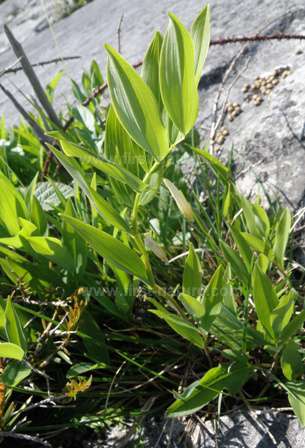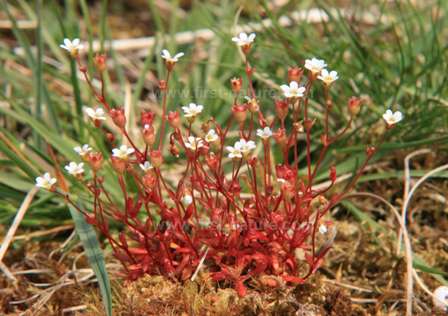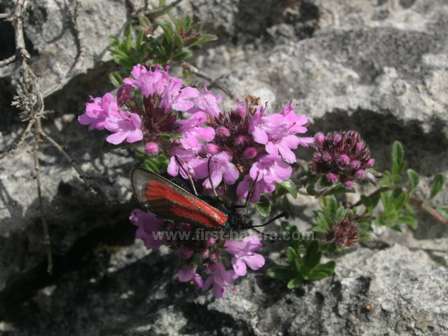Craig y Cilau National Nature Reserve, Near Abergavenny, Monmouthshire
Designations: part of Mynydd Llangatwg SSSI and Usk Bats SAC
Below: Angular Solomon's Seal is one of the special lime-loving plants that grow at Craig y Cilau NNR

Limestone Grassland is a relatively uncommon habitat in Wales, and so a visit to this NNR in spring and summer is a chance to see some of the special plants that grow only in soils that have a high level of alkalinity.
In the reserve there are access points to two extensive cave systems lying beneath the limestone cliff that is the dominant landscape feature of this NNR: the Agen Allwedd cave system and the Eglwys Faen cave system. Both of these cave systems are home to several bat species.
Other features in this ecologically diverse NNR are a small raised bog, which favours acid-tolerant plants, and a woodland which includes no fewer than four species of Whitebeam trees that are native to Britain. Two of these rare tree species are found only in and around the Brecknock area.
Craig y Cilau National Nature Reserve is managed by Natural Resources Wales (NRW).
Directions
Grid Ref: SO186160
For the closest access point to the habitats on the top of the hill, take the A4047 road from Crickhowell southwards across the River Usk. Then turn right into Hilltop Road leading into the village of Llangattock. Once in the village follow Hillside Road for approximately 1/2km and then turn right onto another very narrow, winding and steep lane that will taks you up to the top of the escarpment. Once up on the top look out for another very sharp right hand turn which leads to a track at the end of the road.
Alternatively, there are access points lower down the hill from the unmarked road out of Llangattock which joins the B4506 road between Llangynidr and Bryn Mawr.
Below: Rue-leaved Saxifrage grows at Craig y Cilau NNR

Access
There is open access to the reserve throughout the year, but paths can be slippery and dangerous in wet weather so good walking shoes are essential.
Facilities
Other than interpretation boards there are no facilities at the reserve, but there are shops and cafés in nearby Crickhowell.
Description of Site
Craig y Cilau is one of Wales's most outstanding botanical sites with well over 250 species having been recorded there, some of them very rare. For instance, there are two endemic hawkweeds confined only to this small area: Hieracium cillense and Hieracium asteridiophyllum. Other special plants include Moutain Melick (Melica nutans), Rue-leaved Saxifrage (Saxifraga tridactylites), Mossy Saxifrage (Saxifraga hypnoides), Alpine Enchanter's Nightshade (Circaea alpina) and Angular Solomon's Seal (Polygonatum odoratum).
Below: Wild Thyme and an accompanying daytime-flying Burnet Moth

The exposed rocks at Craig y Cilau have some well developed lichen and moss flora with a number of scarce or rare species being present. Limestone Fern (Gymnocarpium robertianum) grows throughout some parts of the loose, rocky screes in the Reserve, and the thin soils around the cliffs are home to a special drought-resistant plant called Hutchinsia (Hornungia petraea). This member of the Cabbage (Brassicacae) family is what is known as a 'spring ephemeral' - plants that appear briefly in early spring, and then as soon as the soil where they grow dries out, disappear without a trace.
A small raised bog within the Reserve, Waun Ddu, paints a very different floral picture with species much more at home in acid, wet conditions: the carniverous Round-leaved Sundew (Drosera rotundifolia) is there along with Lesser Skullcap (Scuterllaria minor) and Few-flowered Spike Rush (Eleocharis quinqueflora) which has becoming increasingly rare due to land drainage for agricultural purposes. Another lovely plant that flowers in damp spots is Bog Pimpernel (Anagallis tenella).
The Reserve is also known for the woodland there which has four species of Whitebeam trees, two of which are unknown from anywhere else - Sorbus leyana and Sorbus minima. This woodland is also very important because it provides excellent foraging habitat for some of the important occupants of the cave systems - bats.
The most important of the bat species to live in the caves at Craig y Cilau is the Lesser Horseshoe Bat (Rhinolophus hipposideros) which occurs only in the west of Britain and Ireland. Most of the caves in the area have stable populations of Lesser Horseshoe Bats, and some of them use the caves not just for hibernation but to breed in, too. Access to the caves is managed in such a way as to minimise disturbance to the bats, and the continuous belt of woodland provides them with an unhindered corridor of wooded access between the caves and their foraging territories inside the woods.